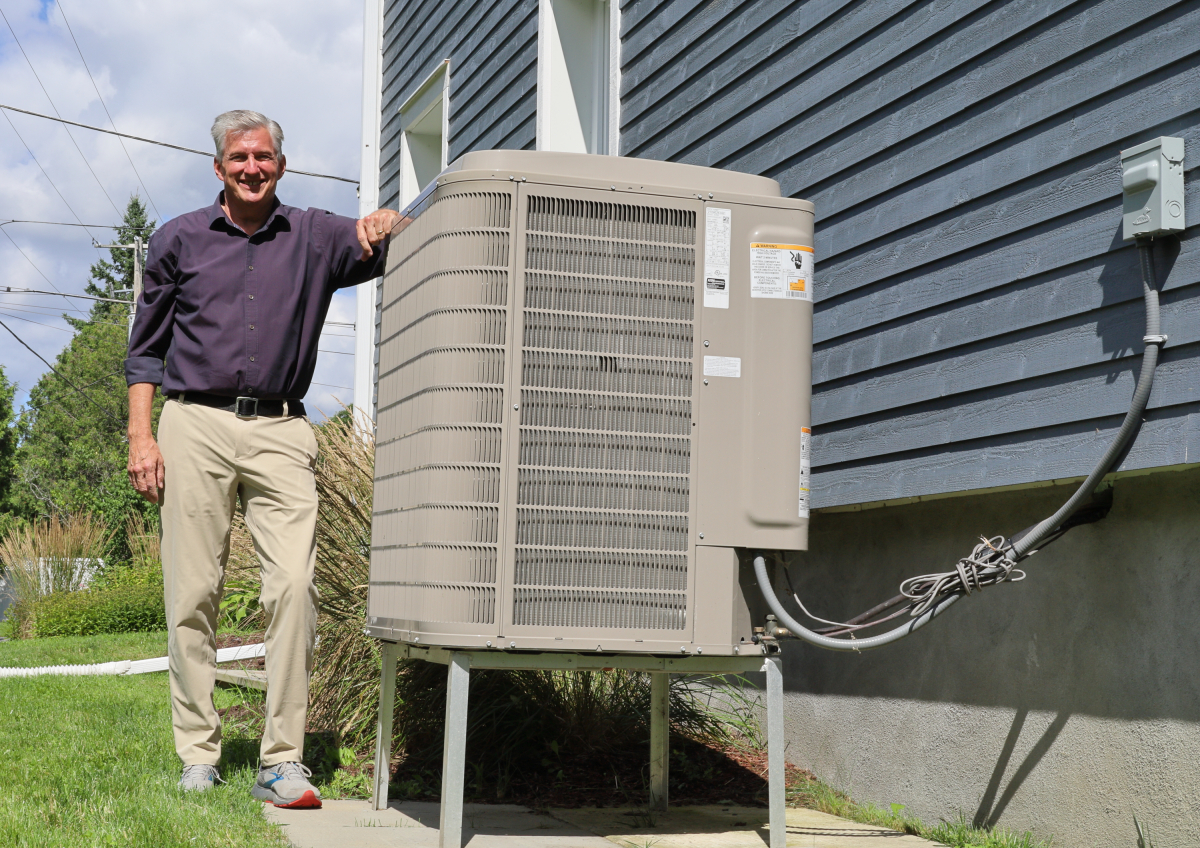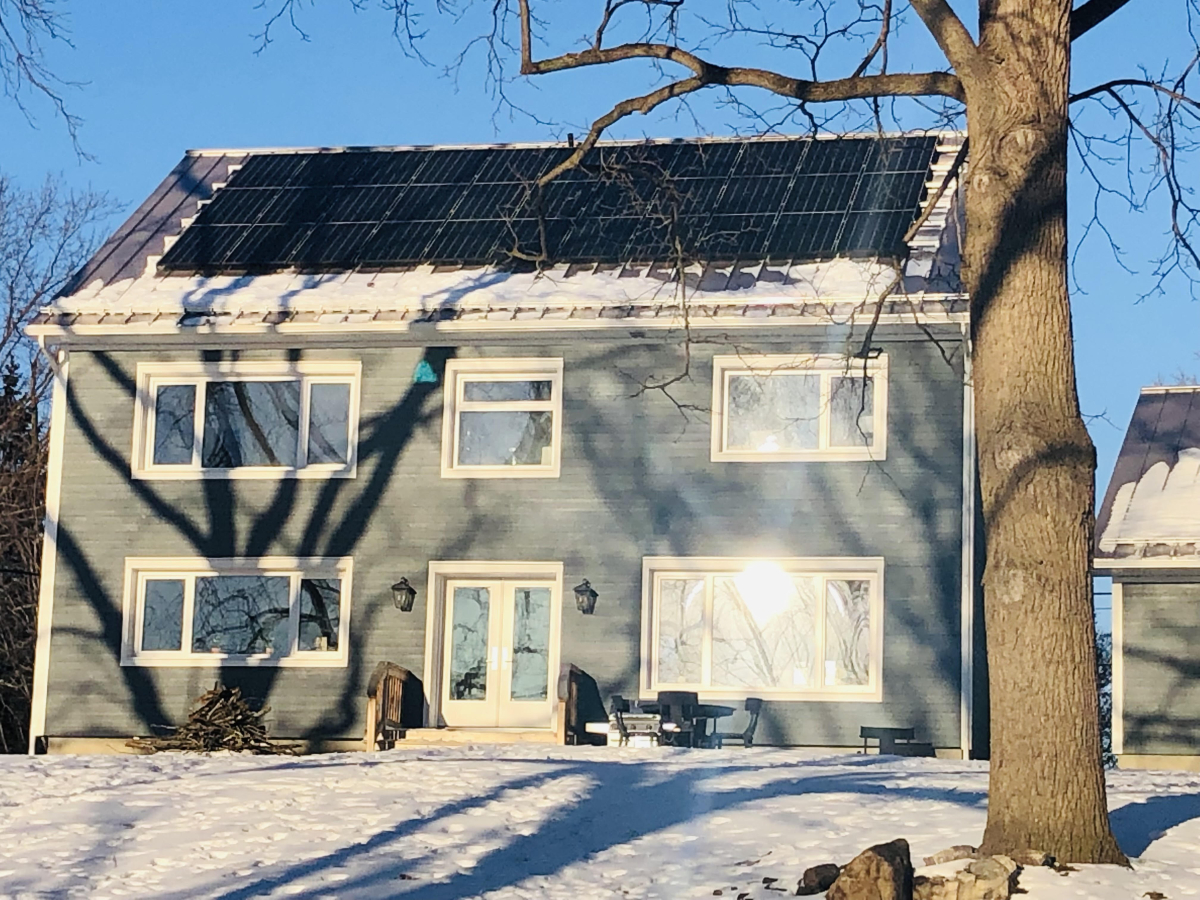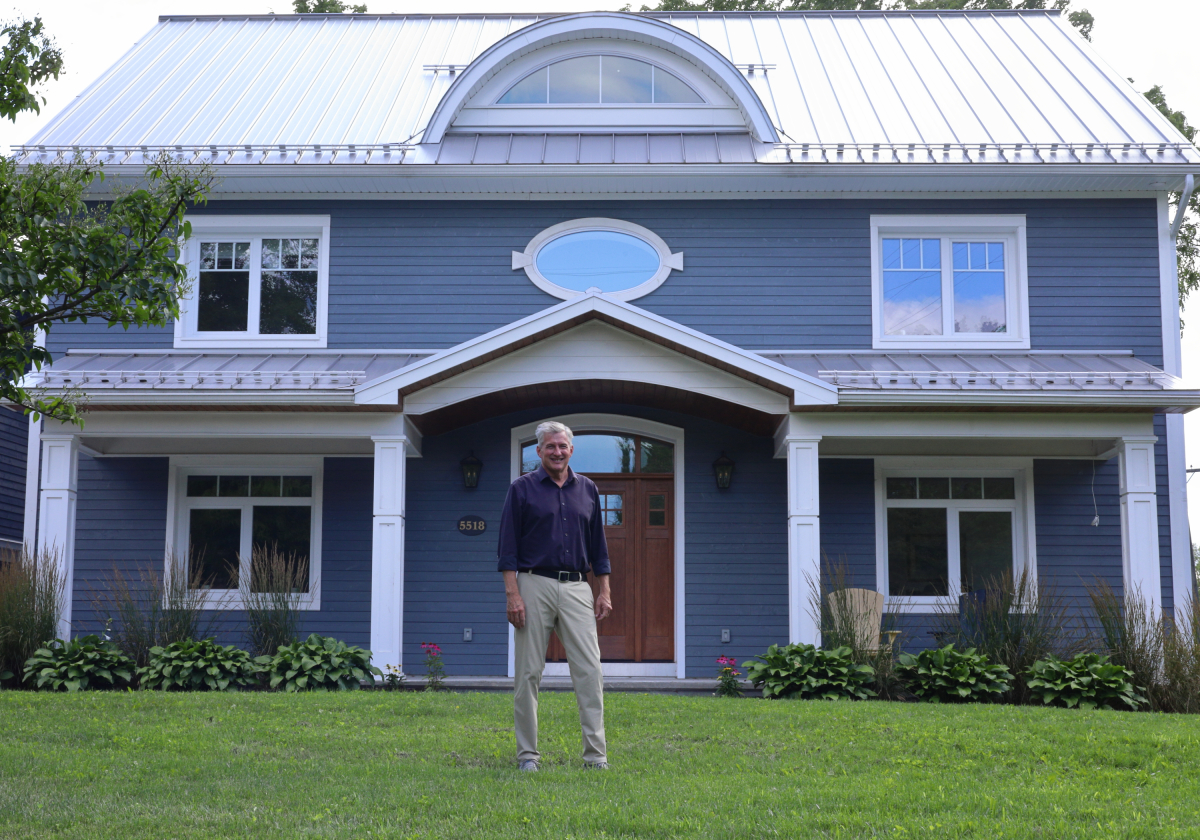Support strong Canadian climate journalism for 2025
Perched on the bank of Ottawa’s Rideau River is a special house, designed with climate in mind.
Outfitted with solar panels, an air source heat pump and electric boiler and furnace, Ottawa resident Bruce Fanjoy’s house is about as close to net zero as you can get.
“We're producing roughly the equivalent amount of energy that the house requires,” Fanjoy told Canada’s National Observer. “The solar array that we have is basically sized for the house.”
During the bright spring and summer months, the solar setup generates excess energy, which is automatically sold back to the utility company in exchange for credits. Fanjoy and his wife use those credits for winter electricity when solar energy production is low.
They have an air source heat pump — which functions like air conditioning and keeps the house pleasantly cool through Ontario’s humid summers — hooked up to an electric furnace in the basement. The heat pump “will function effectively to about -20 C, which takes care of most of the winter,” said Fanjoy. But sometimes Ottawa sees even lower temperatures: last winter, the Ottawa airport recorded seven days that hit -20 C or colder.

When the temperature dips below -20 C, the heat pump is no longer efficient “and the electric furnace just takes over,” said Fanjoy. “It's automatic and we don't notice any difference. The house feels the same. It's always a very comfortable temperature.”
But the house’s energy generation and consumption are only a piece of its nearly non-emitting equation.
Every design element is intentional. The big blue house is positioned to best take advantage of the sun, with the roof angled so the 33 solar panels have maximum exposure. The size and position of the home’s triple-paned windows were selected so the sun’s rays could stream in and passively heat the house during winter.

In November 2019, Fanjoy began construction of the home, dubbed the Millview House, using the internationally recognized Passive House standard as a guide. This sustainable construction concept creates buildings that consume up to 90 per cent less heating and cooling energy than conventional buildings. Although the couple’s home doesn’t have official Passive House certification, Fanjoy abided by the vast majority of its principles. The main exception? A wood stove they wanted for its usefulness in the event of power outages.
Things like how to position a house may seem obvious, but people and companies often don’t take the sun into account when they build homes, said Fanjoy. There are so many important details, like ensuring the structure is as airtight as possible so there are no drafts, and trying to make wall insulation wrap around the house continuously for the best heat-retaining results.
Fanjoy wanted a sustainable home years before he actually built one, but said it was his efforts to make a backyard skating rink for his kids that taught him “you're not going to beat nature, but if you work with nature, you can do beautiful things.”
He is very pleased with the end result and says it is the most comfortable home they have lived in.
“I may be just one person or one family, but … there's a certain amount of risk aversion in all of us and seeing it done makes it easier for others to make the choice,” said Fanjoy.
He says “a lot of people” have taken the first steps because of the Millview House, describing a variety of community members installing solar panels, heat pumps and buying electric cars. Fanjoy is hoping to be the Liberal candidate for the Carleton riding to run against Pierre Poilievre in the next federal election, and said he met some people who are planning to install their own solar panels during his recent neighbourhood canvassing.
Solar panels are a great place to start: the technology is essentially a power plant, accessible to homeowners, unlike hydroelectric, nuclear or even wind, said Fanjoy.
Heat pumps are also key to the solution, but most people will wait until they have to replace their gas furnace or central air conditioner to make the switch.
All these things require an upfront cost, but it's important to view it as an investment, said Fanjoy, adding that along with reducing your utility bills, you protect yourself from energy price inflation over the long term.
Of course, not everyone is in the position to build a house, he acknowledged, but those who are, have a unique opportunity before them.
“What I would recommend is if you're concerned about budget, which most people are, make it smaller,” he said.
“It's not something you do when you have more money… If you can afford a house, then you can afford a sustainable house.”
All the little things — like high-performance doors and windows, insulation and limiting drafts and gaps — add up, and he says there are many days in the winter when their home heats itself just from the sun coming through the windows, without any mechanical support.
“One of the challenges that we face in moving towards a more sustainable world is I think a lot of people think that we're going to lose benefits, it's not going to be as nice, we're gonna have to live in an austere environment,” said Fanjoy. “I don't think that's the case at all. We just do things differently, but it's going to be better.
“Now's a very important time to adapt… If you're in a position to do things a little bit differently, then now's the time.”
Natasha Bulowski / Local Journalism Initiative / Canada’s National Observer






Comments
Some important information is missing, which would help readers decide if this example is relevant to their own circumstances:
- size & design of house (e.g. floor area, is basement finished, no. of bedrooms & bathrooms)
- total cost, and cost of various energy conservation features
- were any subsidy or grant programs used to cover part of the costs, and how much?
- do the solar panels have a battery backup?
Regarding your four points:
- Yes, floor area, number of bedrooms and so on are important bits of information.
- Yes, so is total cost with energy features called out. However, this was a new build and most cities require energy efficiency by Code which is also applied to permits for heavy renovations. In other words, it will cost you either way. The cost is less when it's built into the tender for the structure than retrofitted later, and this results in a distinct energy / cost savings curve over the decades, something ignored when concerned only for the up front costs.
- It's safe to assume most energy equipment did come with grants from the feds and province, possibly even the city and some manufacturers. Said grants stimulate more transitional conversions, but they are often inadequate in some jurisdictions and do not cover necessary electrical upgrades in older houses and the older parts of the grid. It's also safe to assume that the operating cost savings will allow a payback period to be calculated (usually under 15 years with good insulation and efficient triple glazed windows and doors) along with lifetime savings.
- I don't believe there is battery backup in this case because of the advantages of net metering credits. In essence, the grid acts like a giant battery. However, if the power authority decides to eliminate or dramatically lower the NM credit (looking at you BC Hydro!) then home system batteries are readily available and will allow homeowners the option of going off grid, or dramatically reducing one's dependency on the grid to a basic battery top up function. All power input and output will be run through the battery packs. The majority of today's home batteries use lithium iron phosphate chemistry (LFP) which is slightly less energy dense than old school lithium batteries that use cobalt and nickel, which are being slowly replaced due to the relatively rare incidences of fire. LFP batteries last longer and can be routinely charged to 100% without damage. The Tesla PowerWall, Enphase, Franklin and other battery brands will run about $12,000 per unit installed. Two or possibly three of them will be needed in an average grid-independent home, which makes the investment not worth it unless your utility charges really high prices and is unreliable.
Note that Alberta's private power companies recently quintupled their prices and were followed by the economically incompetent slam by the government against their own strong and growing renewable industry. I think many homeowners there will now do the math on solar with batteries and will likely come out even, possibly even go 100% off grid. By extension, entire communities may consider the same thing, that is generating and storing its own power for its own collective use and giving the finger to fossilized politics and grids.
Whole subdivisions and towns going off grid in Alberta ... oh, the irony.
On longevity and warranty, most heat pumps have limited warrantees on parts for up to eight or 10 years. With periodic repairs, the machines should last 15 years or more.
The best solar PV panels have both performance and parts warrantees for 25 years, with performance maintaining a 90+% rate even after that length of time. I found LG was the best brand in independent reviews and warrantees when I was researching rooftop solar three years ago. Batteries ring in at around a decade, with LFP being being the best chemistry in performance over long periods.
"...the grid acts like a giant battery." - No it most certainly does not. Generation must match demand or the grid crashes; i.e., blackout. Intermittent sources of energy like wind and solar requires natural gas to synchronize the output to match the grid if there is no storage - it is a codependency. Wind and solar without energy storage is a scam.
In terms of the conversion of kWh to financial credit, the grid certainly does act like a giant battery. And here in BC electricity comes directly from storage -- in reservoirs.
With MW in grid storage now coming online in huge banks of batteries everywhere, including Alberta where flow batteries made in Vancouver by Invinity store the energy produced in Canada's largest solar farm, gas peaker plants are now obsolete. Form Energy uses iron air technology to store huge amounts of power for up to 100 hours / four days. Massive banks of LFP batteries take milliseconds to meet daily demand over a 4-hour period, Essentially, batteries cover an area from 4 to 100 hours.
Scotland and Australia have moved very quickly into this field and this has allowed the Assie state governments to plan for the quick phase out of coal and gas plants. Moreover, Alberta's own electricity auctions have clearly indicated that solar and wind projects are able to outcompete gas and coal on price.
Defending gas at this point probably indicates that one has shares in or works in the fossil fuel industry.
"...Aussie state governments..."
Without a dollar figure, it's not an environment article, it's more like one of those home-porn sections of a Postmedia paper, selling the awesome houses of some new subdivision.
What's painful is that this is being written about as some special house. It's how every house should be constructed now - total heat conservation, all-electric. The article should have been about how wrong it is that this is special, how these are the new minimum construction standards.
The whole "how much, how much, how much" tack is the kind of hectoring that conservatives focus on though, with the usual peevish subtext that none of this is even necessary since climate change isn't real, and few can afford any of this anyway, let alone ALL of it and right now, which is of course the standard here, so what a bloody waste of time.
But the topic of the article is an example of what's possible AND how comfortable it can actually be, addressing one of the common fears otherwise. It also informs us who is going to be running against Boilievre when the time comes, which further enables all of us to imagine the head finally being cut off of this horrible conservative party when the "leader" himself is defeated by someone far superior.
When just about everything in modern life needs to change it will take time that we don't really have, but whose fault is that? Hence the satisfaction of the image I mentioned.
Never before in human history has anyone posed such an existential threat to our species. That should be our focus at every turn.
Investments are nice, for those who can afford them.
True. But our investment in carbon-free housing benefits everybody - even you.
Investments are especially nice when they result in long term savings benefits. Capital costs are only one part of a two-part story, with lifetime operating costs being chapter two.
Numbers are important in any purchase decision unless one has money to burn or there is no choice. Here in Alberta with private electricity generation electric heating of any form in a cold month is six times the cost of natural gas with gas and electricity purchased at "good" rates. My wish is for hydrogen heating, do not need summer cooling here.
Did you miss the part where the solar generated electricity credits pay for all the electricity needed for heating in the winter? Net cost for electricity = Zero - natural gas won't come close, and neither will hydrogen. My solar powered, all electric, Passive House in BC validates this zero-cost proposition. Payback on the solar panels from excess electricity generation is 5-6 years; and yes, I can get cash rebates for the excess power generation too. When batteries get cheaper I can go off grid entirely.
I should have added location and degree days from the nearest airport are important in analyzing the cost of a technology, if there is any choice.
Hydrogen is problematic in many ways.
A new distribution pipeline grid needs to be built with metal that can handle H. The electrical grid already exists. Hydrogen is new, solar is now standard and far, far cheaper. Hydrogen is clean only when low or zero emission power is used to break H from O in molecules of water through electrolysis. That's very expensive. Blue or grey H comes from the fossil fuel industry and is carbon intensive. Solar is clean, especially now that recycling is built in to end-of-life calculations. Hydrogen grids would be highly centralized. Solar is flexible and can be highly centralized or completely decentralized (i.e. rooftop PV panels), and is less susceptible to be taken over by monopolies. Anyone with moderate construction experience and who can read a Code book can DIY solar at home to an extent. No one in their right mind would DIY H or NG systems without experts standing by.
I'd love to see a short series of stories on an energy retrofit project(s). There are lots of YouTube vids on solar and Passive House projects, but a National Observer three-part piece on one project, like this one in Ottawa, following the steps of planning, design, permits, construction and a performance over a limited period with all costs and analysis included would be great.
Give the guy credit. Want to know the size, look up the passive house book, ask your library. Heck after the 70s oil crisis my new wife and I designed and physically built a 2x6 r20 wall home, r 50 in ceiling , hot water heat which was quiet, efficient and dust free. 1976, then in 1982 a 2x8 home wood basement , air to air heat exchange, then in 86 a 900 sq foot home with lots of South facing windows, a separate furnace room. Even after moving, I have heard from friends, that these early innovations I made were well received due much lower utility bills by the present owners. It was a learning process that we spent money on in a time where energy costs were up but construction standards out of date. Like this gentleman, he made a decision, built it and now lives without monthly energy bills. Water sewer, yes. Give him credit and the reporter too. Want more detail read the book. As a retired building inspector, the house is about 1200 sq feet on each level. Personally my wife and I liked the 900 sq foot bilevel the best. 1 br up, 2 down, ,insulated concrete basement floor, lots of storage. Easy to keep clean and tidy, raised 2 sons in it, had an attached garage. Bright, warm big welcoming kitchen, open floor, angled ceiling , low maintenance exterior including window frames. And now 40 years old, still looking good. Try it yourself, I wish heat pumps, and solar panels had been affordable then,but now they are, and Scandinavian cold winter heat pumps are available to minus 30.
You're an inspiration!
This article illustrates how individual homeowners can proactively initiate changes in how we design and build homes using design principles and building techniques that hopefully will become more commonplace, especially in light of the climate crisis confronting us all. It’s a refreshing anecdote to the world of McMansions and the wanton excess that is all too common in house design and building construction in today’s world.
Beneficial societal change is, more often than not, initiated by adventurous individuals with foresight and determined conviction rather than by the institutions of society which tend to reinforce the status quo.
Unfortunately, it’s been my experience that most architects, designers and those in the construction industry are generally more concerned with image than functionality and efficiency of design. Otherwise, today’s buildings, whether houses, commercial buildings or industrial buildings, would be designed and constructed using much higher insulation values, with much more attention paid to designing with solar exposure in mind, and more passive solar design attributes incorporated into the building design (i.e. heat sinks, roofs optimally designed for solar panels, etc).
But this owner/builder also touches on some other very important issues and aspects of building design and construction that aren’t usually incorporated or considered when designing a building: namely, the need for a smaller environmental building footprint encompassing everything from the
materials used and the size of the building, to the waste stream generated and how much of an impact the essential workings of the building will have on the environment in the long run.
Building smaller, more energy efficient buildings is a definite necessity in the battle to address climate change. Building smaller and smarter also frees up more resources for more buildings; which means more buildings constructed using the same amount of resources. It also means lower construction costs per unit which should also help the current housing crisis.
A change in society’s mindset around housing, how we use earth’s diminishing resources, how we heat and cool our buildings, and how we generate (and store) energy, opens up a plethora of possibilities to address a number of issues including the climate crisis and housing availability and affordability.
Just imagine if we started using the many millions of roof tops in Canada for solar panel installations, including all of the often flat-roofed commercial and industrial buildings in addition to residential buildings. Doing so would generate so much extra (renewable) electricity that we’d never be saddled with a sixteen billion dollar dam again. Coupled with sufficient storage capacity and the lower energy demand associated with building smaller, better designed and more energy efficient buildings, there’s a huge, relatively untapped supply of energy available to power our transition to a sustainable, lower carbon future. All we have to do is change our priorities. For instance, take the billions in subsidies that currently go to the O&G industry and work out a program of grants (based on income) to subsidize the installation of renewable energy infrastructure on residential housing, as well as other suitable projects.
An aside: one of the best books to read about designing homes, neighbourhoods and communities in my opinion is: A Pattern Language, by Christopher Alexander. Absolutely fascinating and very informative!
Exemplary comments!
Michael Green is a Vancouver architect who specializes in energy conservation and sustainable wood structures, including a 23-story student housing tower at UBC made from mass timber sourced from sustainably managed regional tree plantations.
The Leadership in Energy and Environment Design (LEEDs) standards have been around for many years, and it has become a specialty field with design consultants. There are several levels with Plantinum being the highest. There is also Neighbourhood LEEDs which covers urban design principles beyond individual buildings and which directly pertains to holistic town planning.
One of my oldest interests is in sustainable human-scaled urbanism. The 20th Century oversized single family home on a large lot is made obsolete under 21st Century urbanism. Imagine small houses on half lots, rowhouses, townhouses and low rise apartments built to Passive House standards in neighborhoods zoned for multiple uses, including high streets with continuous sidewalk retail within walking distance of the majority of residents. And decent transit service.
One day it may be possible for an entire walkable town to be designed from scratch with these principles and programs, and to achieve energy independence by accommodating several hundred thousand square metres of private solar roofs net metered with a large scale community battery bank and distribution grid. You generate power for a per kWh credit, which is redeemed when your consumption demands it.
With deep conservation this town will have a low demand for energy, be zero emission during operations, have low car dependency levels and be filled with healthier people who walk more and who support their local businesses which are much, much closer to home than an average suburban mall surrounded by an ocean of asphalt dedicated to the extremely low value use of parking.